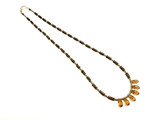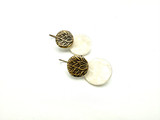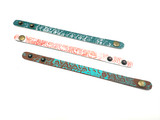Glossary of Jewelry-Making Terms
Antiqued: Beads or Findings that have had their surfaces treated to appear oxidized ("distressed" or aged). Antiqued metal beads have either a genuine patina, a plating, or a other coating which simulates an oxidized or tarnished surface. Antiqued bone beads are dyed a darker hue, often with the use of natural dyes such as tea. The crevices of antiqued beads, charms and findings often appear darker while the raised areas are often polished, to mimic the appearance of actual old, worn beads.
Aurora Borealis (AB): An iridescent multicolored coating, similar to an iris coating, usually applied to translucent glass and crystal beads. Aurora borealis is often abbreviated as AB.
Ghost: Matte glass beads that have an aurora borealis coating.
Gross (GR): a unit of measure (quantity) that beads are sometime sold in. For information on this and other measurement terms, see our Units of Measure Glossary.
Iris: An iridescent coating, similar to aurora borealis, that is usually applied to dark, opaque glass and crystal beads.
Matte: Not shiny. Matte glass beads have usually been chemically etched (frosted).
Opaque: No light can pass through. Examples: Pearls, Turquoise, Hematite, Lapis, Malachite.
Oxidation: In common speech this term is often used interchangeably with antiquing, corrosion, rusting and tarnishing, but chemically these processes are more complicated. That's a discussion for another day.
Plating: Plating is a method in which a thin layer of metal is adhered to the surface of an object. The metal to be adhered to the base goods is usually suspended in fluid. A combination of electricity, fluid, and movement cause the plating material to adhere to the base goods. Often jewelry findings are plated with a more expensive metal than the metal of the base goods – this provides a nicer finish. Three main methods of plating are as follows:
- barrel plating: In this form of plating, a batch of goods is tumbled in a "barrel" which is immersed in the plating fluid. The tumbling provides an economical way to ensure that each part of the items are exposed to the plating. If two items are temporarily stuck together for some reason, the sides that were touching will not become plated. We used to have this problem with bolo tips. If one was wedged inside of another in the plating barrel, the tip of the stuck bolo tip didn't get plated, the inside of the other tip didn't get plated, and when we pulled them apart, there was nasty green fluid inside.
- basket plating: This form of plating is used for objects that would get damaged in the tumbling process of barrel plating, and would also not attach easily to a rack, for rack plating (see below). Hat Pins with heads are an example of the type of object that is basket plated. For this method, objects are spread out in a "basket" – making sure they don't touch – and the basket is then immersed in the plating fluid. Basket plating is more expensive than barrel plating.
- rack plating: In rack plating, the base goods are attached to a "rack" which is then immersed in the plating fluid. The goods do not tumble around, and therefore do not become tangled (in the case of chain) or closed (in the case of lockets, which need to be plated inside and out.) Rack plating is considerably more expensive than other methods.
Translucent: Literally means "light passes through." Distinct from clear (transparent) objects, you can't necessarily see objects on the other side of a translucent object. Examples: Diamonds, Rubies, Sapphires, Emeralds.
Transparent: Not only can light pass through it, but you can also see clearly through it. Transparent is more clear than translucent. Hopefully, your car's windshield is transparent, not just translucent.
Our Bead Blog
-
Edgy Elegance Necklace
Mar 22nd 2024Created by: Guest Designer Deb FlorosSuggested Supplies 1 #20-111-204 TOHO Glass Seed Bead, Size 11
-
Elegant Button Earrings
Mar 22nd 2024Created by: Guest Designer Deb FlorosSuggested Supplies 1 #27-841-042-50 Beadalon Bead Bumper, 1.5m
-
Abstract Painted Cuffs
Feb 26th 2024Created by: Guest Designer Deb FlorosSuggested Supplies 1 #51-810-05-17 Leather Cuff Bracelet, 1/2"



